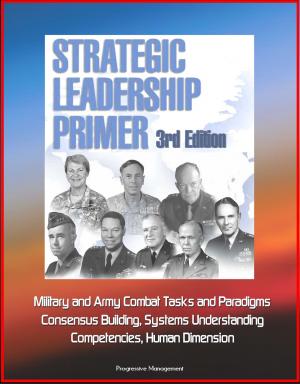Fighting the Big War with the Small Hammer: Operational Planning for the Medium Force – Case Studies and Tempo Analysis of World War II German Army Battle of Mortain, Defeat at Argentan-Falaise Gap
Nonfiction, History, Military, Strategy, World War II| Author: | Progressive Management | ISBN: | 9781370681983 |
| Publisher: | Progressive Management | Publication: | February 8, 2017 |
| Imprint: | Smashwords Edition | Language: | English |
| Author: | Progressive Management |
| ISBN: | 9781370681983 |
| Publisher: | Progressive Management |
| Publication: | February 8, 2017 |
| Imprint: | Smashwords Edition |
| Language: | English |
This excellent report has been professionally converted for accurate flowing-text e-book format reproduction. The asymmetry of medium versus heavy operations creates a problem for the medium force. This problem is relevant because the strategic direction of the United States encourages the growth of medium forces. This means the study of medium versus heavy operations becomes a concern should an existential war occur. This monograph addresses the elements of operational art that are most critical during medium versus heavy operations. Section one uses an aggregate caliber calculation to compare US and German divisional combat power. Sections two and three use the contemporary US Army definition and description of operational art to analyze the American defense at Mortain and the Allied defeat of two German armies at Falaise-Argentan. The American success defending at Mortain and encircling the Germans at Falaise-Argentan illustrates the importance of tempo, transitions, and phasing. The Allied tempo all along the Normandy Front prevented the Germans from massing the required combat power to make an effective attack against the Americans at Mortain. Furthermore, the Allied tempo caused a deep salient to form around two German Armies extending from Mortain to Falaise and Argentan. However, the Americans reduced their tempo at Argentan and transitioned poorly to close the encirclement. This allowed the Germans to hold open the gap for an additional five days and gave the Germans the space required to conduct a breakout. Given these historical examples, the most critical elements of operational art are tempo, transitions, and phasing during medium versus heavy operations. Operational planners should use phasing to focus assets in a way that enables tempo.
Acronyms * Introduction * Section One: The Case for Medium in World War II * The Search for a Functional Definition of Medium Forces * The Medium Applied in World War II * Avoiding the Medium versus Heavy Fight * Conclusion * Section Two: The Battle of Mortain * Methodology and Criteria: Tempo Related to Mass * Overview: The Battle of Mortain * Analysis: Mortain, Tempo, and Operational Art * Conclusion * Section Three: Argentan-Falaise * Methodology and Criteria: OODA Loop and Tempo * Overview: German Defeat at Argentan-Falaise Gap * Analysis: Argentan-Falaise, Tempo, and Operational Art * Analysis: Argentan-Falaise, Transitions, and Operational Art * Conclusion * Conclusion * Recommendations
In December 1944, I Company, 23rd Infantry Regiment defended east of Elensborn, Belgium against a German attack in the opening blows of the Battle of the Bulge. I Company stood against seven German infantry assaults that day. Then it happened. Five Tiger tanks appeared and lumbered toward I Company's position with infantry support. Captain Charles MacDonald, I Company's Commander, requested a Sherman tank platoon to intervene against the enemy armor. While waiting for an answer, he tried to stop the Tigers with artillery, but without a direct hit, the Tigers kept coming. The Tigers poured round after round of 88mm destruction on I Company. MacDonald's Battalion Commander responded that the Sherman tank platoon refused to close with the Tigers, because it was suicide for the lightly armored tanks. The Battalion Commander agreed with their judgment. Neither I Company nor the 23rd Regiment possessed a way to stop the Tigers. MacDonald's defense folded.
This excellent report has been professionally converted for accurate flowing-text e-book format reproduction. The asymmetry of medium versus heavy operations creates a problem for the medium force. This problem is relevant because the strategic direction of the United States encourages the growth of medium forces. This means the study of medium versus heavy operations becomes a concern should an existential war occur. This monograph addresses the elements of operational art that are most critical during medium versus heavy operations. Section one uses an aggregate caliber calculation to compare US and German divisional combat power. Sections two and three use the contemporary US Army definition and description of operational art to analyze the American defense at Mortain and the Allied defeat of two German armies at Falaise-Argentan. The American success defending at Mortain and encircling the Germans at Falaise-Argentan illustrates the importance of tempo, transitions, and phasing. The Allied tempo all along the Normandy Front prevented the Germans from massing the required combat power to make an effective attack against the Americans at Mortain. Furthermore, the Allied tempo caused a deep salient to form around two German Armies extending from Mortain to Falaise and Argentan. However, the Americans reduced their tempo at Argentan and transitioned poorly to close the encirclement. This allowed the Germans to hold open the gap for an additional five days and gave the Germans the space required to conduct a breakout. Given these historical examples, the most critical elements of operational art are tempo, transitions, and phasing during medium versus heavy operations. Operational planners should use phasing to focus assets in a way that enables tempo.
Acronyms * Introduction * Section One: The Case for Medium in World War II * The Search for a Functional Definition of Medium Forces * The Medium Applied in World War II * Avoiding the Medium versus Heavy Fight * Conclusion * Section Two: The Battle of Mortain * Methodology and Criteria: Tempo Related to Mass * Overview: The Battle of Mortain * Analysis: Mortain, Tempo, and Operational Art * Conclusion * Section Three: Argentan-Falaise * Methodology and Criteria: OODA Loop and Tempo * Overview: German Defeat at Argentan-Falaise Gap * Analysis: Argentan-Falaise, Tempo, and Operational Art * Analysis: Argentan-Falaise, Transitions, and Operational Art * Conclusion * Conclusion * Recommendations
In December 1944, I Company, 23rd Infantry Regiment defended east of Elensborn, Belgium against a German attack in the opening blows of the Battle of the Bulge. I Company stood against seven German infantry assaults that day. Then it happened. Five Tiger tanks appeared and lumbered toward I Company's position with infantry support. Captain Charles MacDonald, I Company's Commander, requested a Sherman tank platoon to intervene against the enemy armor. While waiting for an answer, he tried to stop the Tigers with artillery, but without a direct hit, the Tigers kept coming. The Tigers poured round after round of 88mm destruction on I Company. MacDonald's Battalion Commander responded that the Sherman tank platoon refused to close with the Tigers, because it was suicide for the lightly armored tanks. The Battalion Commander agreed with their judgment. Neither I Company nor the 23rd Regiment possessed a way to stop the Tigers. MacDonald's defense folded.















